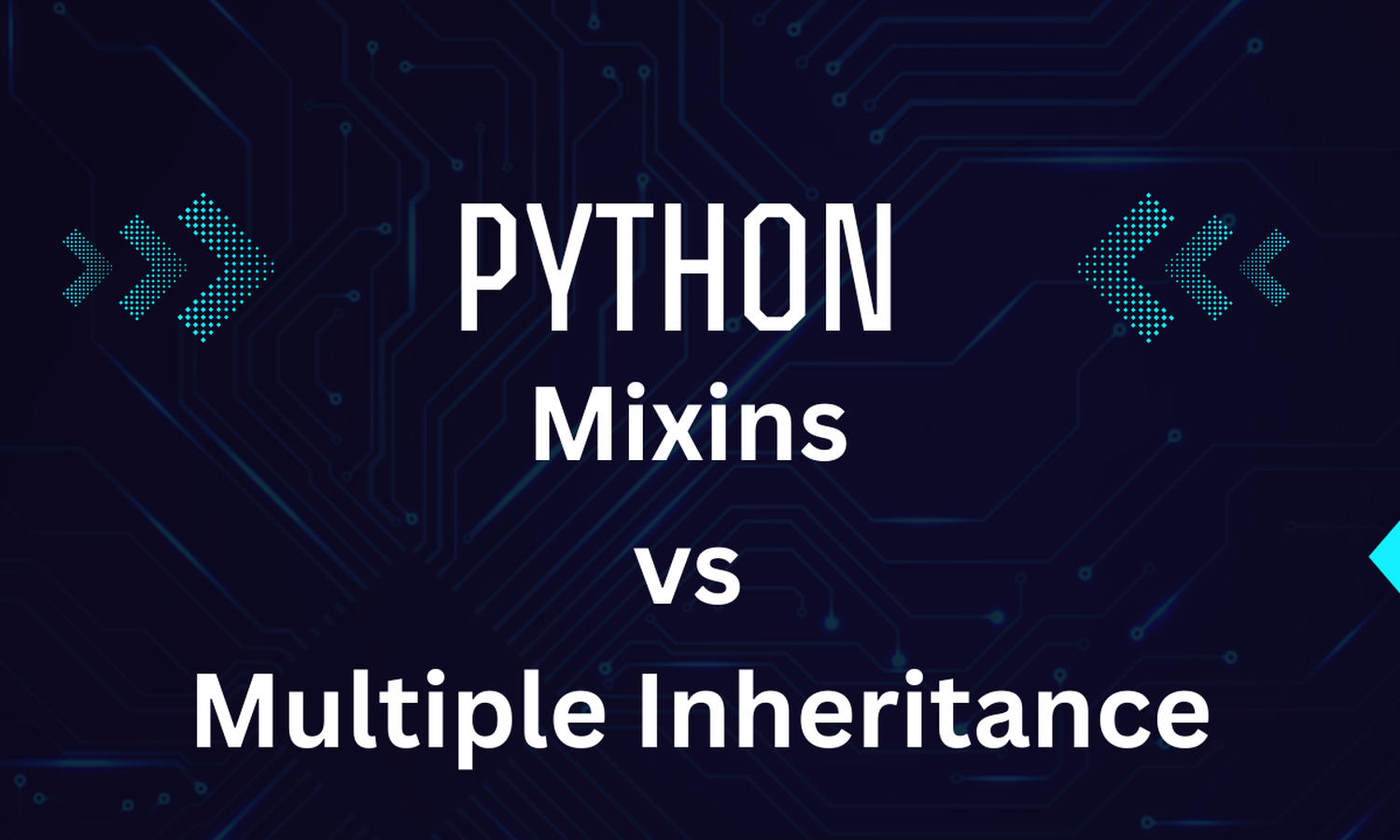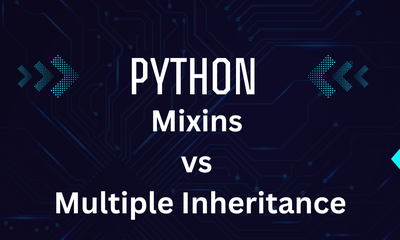Hiểu về Đa kế thừa và Mixin trong Python
By JoeVu, at: 10:10 Ngày 21 tháng 8 năm 2024
Thời gian đọc ước tính: __READING_TIME__ phút


Hiểu về Đa kế thừa và Mixin trong Python
Lập trình hướng đối tượng (OOP) là một mô hình lập trình sử dụng đối tượng và lớp để tổ chức mã theo cách mô đun và có thể tái sử dụng hơn. Python, một ngôn ngữ mạnh mẽ và linh hoạt, hỗ trợ đầy đủ OOP, cho phép các nhà phát triển tạo ra các ứng dụng hiệu quả và tinh vi.
Trong bài đăng này, chúng ta sẽ khám phá những nguyên tắc cơ bản của đa kế thừa và mixin trong Python, lợi ích và những cạm bẫy tiềm ẩn của chúng, cùng với các ví dụ thực tế.
Các khái niệm cốt lõi của OOP
Trước khi đi sâu vào đa kế thừa và mixin, hãy cùng xem lại một số khái niệm cốt lõi của OOP:
- Lớp: Bản thiết kế để tạo đối tượng. Nó định nghĩa một tập hợp các thuộc tính và phương thức mà các đối tượng được tạo từ lớp đó sẽ có.
- Đối tượng: Một thể hiện của một lớp. Đó là một triển khai cụ thể của lớp với các giá trị thực tế.
Ví dụ:
class Dog:
def __init__(self, name, age):
self.name = name
self.age = age
def say(self):
print(f"{self.name} can eat!")
my_dog = Dog("Ducky", 3)
my_dog.say() # Output: Ducky can eat!
Đa kế thừa
Đa kế thừa là gì?
Trong Python, đa kế thừa cho phép một lớp kế thừa từ nhiều hơn một lớp cơ sở. Điều này có nghĩa là lớp dẫn xuất có thể truy cập vào các thuộc tính và phương thức của tất cả các lớp cha của nó. Mặc dù điều này có thể mạnh mẽ, nhưng nó cũng có thể gây ra sự phức tạp, đặc biệt là trong các ứng dụng lớn.
Điều này không bao giờ xảy ra đối với PHP
Cú pháp
Cú pháp cho đa kế thừa rất đơn giản. Bạn chỉ cần liệt kê các lớp cha trong dấu ngoặc đơn, phân tách bằng dấu phẩy.
class Vehicle:
def __init__(self, make, model):
self.make = make
self.model = model
def drive(self):
return f"{self.make} {self.model} is driving."
class Electric:
def __init__(self, battery_capacity):
self.battery_capacity = battery_capacity
def charge(self):
return f"Charging battery with capacity {self.battery_capacity} kWh."
class ElectricCar(Vehicle, Electric):
def __init__(self, make, model, battery_capacity):
Vehicle.__init__(self, make, model)
Electric.__init__(self, battery_capacity)
# Usage
my_car = ElectricCar("Tesla", "Model S", 100)
print(my_car.drive()) # Tesla Model S is driving.
print(my_car.charge()) # Charging battery with capacity 100 kWh.
Ví dụ về Đa kế thừa
Hãy xem xét một ví dụ thực tế để hiểu rõ hơn về đa kế thừa.
class Person:
def __init__(self, name, age):
self.name = name
self.age = age
def get_details(self):
return f"Name: {self.name}, Age: {self.age}"
class Worker:
def __init__(self, job_title, salary):
self.job_title = job_title
self.salary = salary
def get_job_details(self):
return f"Job Title: {self.job_title}, Salary: {self.salary}"
class Manager(Person, Worker):
def __init__(self, name, age, job_title, salary):
Person.__init__(self, name, age)
Worker.__init__(self, job_title, salary)
def get_full_details(self):
return f"{self.get_details()}, {self.get_job_details()}"
manager = Manager("Alice", 35, "Project Manager", 80000)
print(manager.get_full_details())
Kết quả:
Name: Alice, Age: 35, Job Title: Project Manager, Salary: 80000
Những lỗi thường gặp với Đa kế thừa
Quên gọi __init__ của tất cả các lớp cơ sở: Một lỗi thường gặp là quên gọi phương thức __init__ của tất cả các lớp cha. Điều này có thể dẫn đến các thuộc tính chưa được khởi tạo.
class A:
def __init__(self):
self.a = "A"
class B:
def __init__(self):
self.b = "B"
class C(A, B):
def __init__(self):
A.__init__(self)
# Quên khởi tạo B
# B.__init__(self) is missing!
c = C()
print(c.b) # Raises AttributeError: 'C' object has no attribute 'b'
Thứ tự giải quyết phương thức MRO (Method Resolution Order) không chính xác: Nếu không cẩn thận với tên phương thức, Python có thể gọi nhầm phương thức do MRO không mong muốn. Điều này có thể xảy ra khi các lớp cơ sở có các phương thức cùng tên nhưng có triển khai khác nhau.
class A:
def greet(self):
print("Hello from A")
class B(A):
def greet(self):
print("Hello from B")
class C(A):
def greet(self):
print("Hello from C")
class D(B, C):
pass
d = D()
d.greet() # Output: Hello from B (MRO chooses B first)
Mẹo: Luôn kiểm tra MRO bằng cách sử dụng ClassName.mro() để hiểu thứ tự giải quyết phương thức.
Mixin trong Python
Mixin là gì?
Mixin là một loại đa kế thừa đặc biệt. Đó là một lớp được thiết kế để cung cấp các phương thức cho các lớp khác nhưng không nhằm mục đích hoạt động độc lập. Mixin thường được sử dụng để thêm chức năng có thể tái sử dụng vào các lớp một cách mô đun. Không giống như kế thừa truyền thống, mixin thường nhỏ và tập trung vào một chức năng duy nhất.
Ví dụ về Mixin
Hãy tạo một lớp Mixin để thêm chức năng ghi nhật ký vào bất kỳ lớp nào kế thừa từ nó.
class LogMixin:
def log(self, message):
print(f"[LOG]: {message}")
class Person:
def __init__(self, name, age):
self.name = name
self.age = age
def get_details(self):
return f"Name: {self.name}, Age: {self.age}"
class Manager(Person, LogMixin):
def __init__(self, name, age, job_title):
super().__init__(name, age)
self.job_title = job_title
def get_job_details(self):
self.log(f"Getting job details for {self.name}")
return f"Job Title: {self.job_title}"
manager = Manager("Alice", 35, "Project Manager")
print(manager.get_details())
print(manager.get_job_details())
Kết quả:
Name: Alice, Age: 35 [LOG]: Getting job details for Alice Job Title: Project Manager
Những lỗi thường gặp với Mixin
Sử dụng Mixin không chính xác: Mixin không nên được sử dụng như các lớp độc lập. Chúng được dùng để kết hợp với các lớp khác để cung cấp chức năng bổ sung. Ví dụ, mã sau đây có thể dẫn đến sự nhầm lẫn hoặc lỗi:
class LogMixin:
def log(self, message):
print(f"[LOG]: {message}")
log_mixin = LogMixin()
log_mixin.log("Test message") # Mặc dù điều này hoạt động, nhưng nó không phải là cách sử dụng mixin như ý định.
Quá phức tạp với quá nhiều Mixin: Rất dễ bị cuốn vào và tạo ra một lớp kế thừa từ nhiều mixin, dẫn đến hệ thống kế thừa phức tạp và khó hiểu. Luôn cố gắng giữ cho mixin của bạn tập trung và mô đun.
class LogMixin:
pass # Just an example
class AuthMixin:
pass # Another example
class FileManager(LogMixin, AuthMixin):
pass # Kế thừa từ quá nhiều mixin có thể dẫn đến sự nhầm lẫn.
Mẹo: Mixin nên nhỏ và tập trung vào việc thêm một chức năng, chẳng hạn như ghi nhật ký hoặc xác thực, để tránh làm cho hệ thống lớp của bạn quá tải.
So sánh: Đa kế thừa so với Mixin
-
Đa kế thừa:
- Trường hợp sử dụng: Khi bạn cần kết hợp nhiều lớp cơ sở với các chức năng riêng biệt.
- Độ phức tạp: Có thể dẫn đến MRO phức tạp và khó hiểu, đặc biệt là với vấn đề hình thoi.
- Ví dụ: Kết hợp
PersonvàWorkerđể tạoManager.
- Trường hợp sử dụng: Khi bạn cần kết hợp nhiều lớp cơ sở với các chức năng riêng biệt.
-
Mixin:
- Trường hợp sử dụng: Khi bạn muốn thêm chức năng có thể tái sử dụng vào nhiều lớp mà không tạo ra các hệ thống phân cấp phức tạp.
- Độ phức tạp: Đơn giản hơn và mô đun hơn so với đa kế thừa. Tập trung vào việc thêm hành vi cụ thể.
- Ví dụ: Thêm chức năng ghi nhật ký vào nhiều lớp bằng cách sử dụng
LogMixin.
- Trường hợp sử dụng: Khi bạn muốn thêm chức năng có thể tái sử dụng vào nhiều lớp mà không tạo ra các hệ thống phân cấp phức tạp.
Thực tiễn tốt nhất
- Sử dụng Mixin cho chức năng có thể tái sử dụng: Khi bạn cần thêm hành vi chung cho nhiều lớp, hãy sử dụng mixin.
- Hạn chế việc sử dụng Đa kế thừa: Tránh các hệ thống phân cấp phức tạp có thể dẫn đến MRO khó hiểu.
- Giữ cho Mixin tập trung: Thiết kế mixin để cung cấp một chức năng hoặc hành vi duy nhất.
- Sử dụng Thành phần hơn là Kế thừa: Trong nhiều trường hợp, thành phần (sử dụng các thể hiện của các lớp khác) có thể là lựa chọn thiết kế tốt hơn so với kế thừa.
Kết luận
Đa kế thừa và mixin là những công cụ mạnh mẽ trong Python cho phép tạo ra mã linh hoạt và có thể tái sử dụng. Trong khi đa kế thừa cho phép một lớp kế thừa từ nhiều hơn một lớp cơ sở, mixin cung cấp một cách để thêm chức năng mô đun mà không tạo ra các hệ thống phân cấp phức tạp. Bằng cách hiểu sự khác biệt, những lỗi thường gặp và các thực tiễn tốt nhất, bạn có thể tận dụng những tính năng này để cải thiện các dự án Python của mình.
Hãy nhớ, sử dụng mixin để thêm các hành vi cụ thể và hạn chế việc sử dụng đa kế thừa để tránh sự phức tạp. Như mọi khi, hãy cố gắng giữ cho thiết kế mã của bạn đơn giản và rõ ràng.

![[TIPS] Refactoring - Clean Code - Tip 7 - Encapsulate Data and Behavior in Classes](/media/filer_public_thumbnails/filer_public/33/46/334634c4-a8c1-4eda-9e51-38e8df8dc0ef/refactoring_tips_encapsulate_data_and_behavior_in_classes.png__400x240_crop_subsampling-2_upscale.png)
![[TIPs] Python: Compare Tuple and List](/media/filer_public_thumbnails/filer_public/ca/4e/ca4e70d6-3a85-4b47-9067-af7652fdca83/python_tuples_vs_lists.png__400x240_q85_crop_subsampling-2_upscale.jpg)
![[TIPS] Widely-used REGEX](/media/filer_public_thumbnails/filer_public/f4/97/f4979da2-bae0-44e5-808a-d64bb81fd9ce/rgex_applications.png__400x240_crop_subsampling-2_upscale.png)

